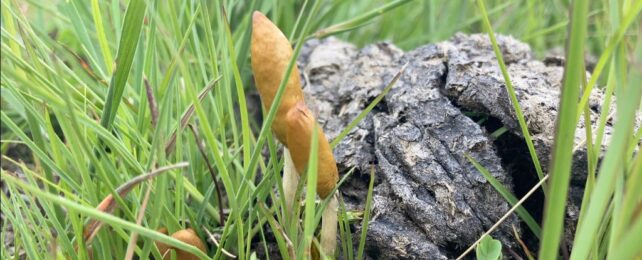Planet Earth is home to possibly hundreds of species of magic mushroom that contain the hallucinogen, psilocybin. Systematic fieldwork surveys of the genus, Psilocybe, however, are "entirely lacking" for many regions of the world.
Now, a new paper describes two species of magic mushroom in southern Africa that are wholly new to science. That brings the total number of reported Psilocybe mushrooms on the continent from just four to six.
One of the species, called Psilocybe maluti, is the first scientifically documented magic mushroom with traditional, spiritual uses in Africa.
P. maluti was originally photographed in 2021 growing on cow manure in the Free State province of South Africa. The golden caramel cap of the fruiting body was collected by self-taught mycologist Daniella Mulder, who sent the unusual looking specimens and some images of them to mycologist Breyten van der Merwe from Stellenbosch University in South Africa for further morphological and genetic analysis.

When it was determined to be a new species, another self-taught mycologist named Cullen Clark along with scientists at Stellenbosch went searching for other mushrooms like it. They found matching specimens in the Kingdom of Lesotho, a landlocked nation fully surrounded by South Africa.
The team got in touch with Mamosebetsi Sethathi, a traditional healer of the kingdom's most prominent ethnic group; the Basotho people. Sethathi kindly shared their traditional uses for the fruiting bodies of P. maluti.
According to anecdotes, local Basotho healers called lingaka (plural) or ngaka (singular) consume the conically capped mushrooms as part of spiritual tradition. Basotho shamans, called linohe, use the mushrooms to "foresee the future".
Other healers, known as ngaka-chitja, occasionally use the mushrooms in association with their "vast knowledge of herbs and remedies" to treat others. Along with the psychoactive plant Boophone disticha, the magic mushrooms are steeped in a strong tea known as koae-ea-lekhoaba, which is sometimes used in traditional medicine or hunting poison.
When a patient drinks the brew, they enter a "trance-like state" and are placed in front of a reflective surface, so they may relay what they are seeing to the healer. The healer then interprets the results and advises the patient on how best to proceed.
"This appears to be the only recorded firsthand report of hallucinogenic mushrooms being used traditionally in Africa and the first mention of hallucinogenic mushroom use in Sub-Saharan Africa," write the Stellenbosch University led team.
"The knowledge shared and discussed in this study has been passed down through generations by word of mouth."
The other newly described species found in Africa has been named P. ingeli. Found in 2023 by amateur mycologist Talan Moult in a coastal province of South Africa, the fruiting bodies of this novel species were growing on grass enriched with cow manure toward the end of the rainy season.

The gills are light colored and the cap is dark compared to the species' closest genetic relative in Asia, called P. keralensis. Unlike P. maluti it has only been found growing in this one province.
Researchers at Stellenbosch hope that their current paper will encourage further research into southern Africa's diversity of mushrooms. The lead authors, van der Merwe and microbiologist Karin Jacobs, say they are indebted to self-taught mycologists who are helping to survey Africa's Psilocybe mushrooms.
"There are only a handful of mycologists in Africa documenting local biodiversity," says Jacobs, who runs the lab at Stellenbosch.
"Collaborating with citizen mycologists is therefore hugely beneficial. In addition to more material, collaboration also opens avenues for conversation and exploration, which can lead to documenting mycophilia (the love of mushrooms) on the African continent."
The study was published in Mycologia.
